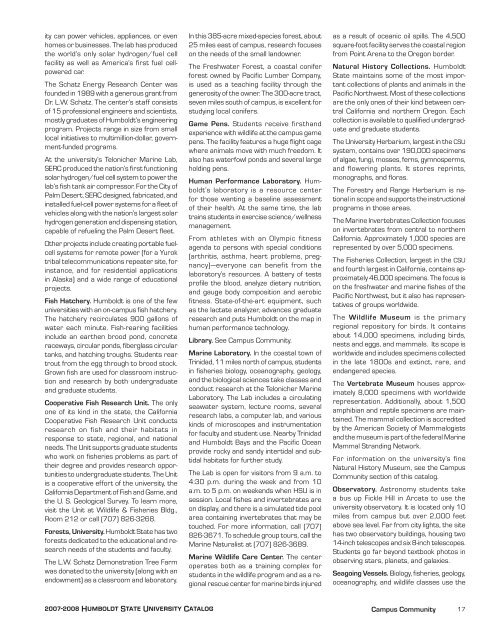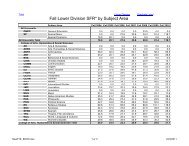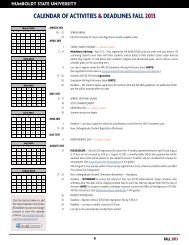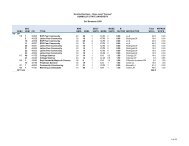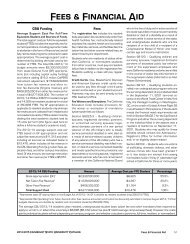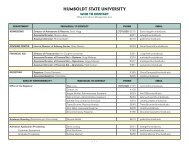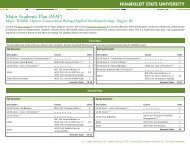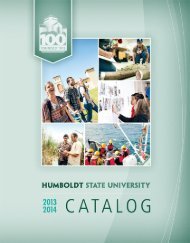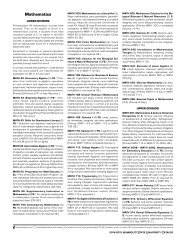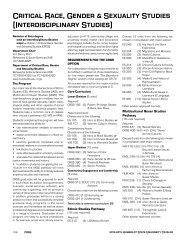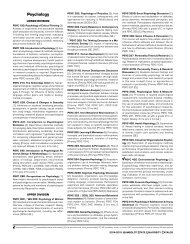2007-08 Academic Year - Humboldt State University
2007-08 Academic Year - Humboldt State University
2007-08 Academic Year - Humboldt State University
You also want an ePaper? Increase the reach of your titles
YUMPU automatically turns print PDFs into web optimized ePapers that Google loves.
ity can power vehicles, appliances, or even<br />
homes or businesses. The lab has produced<br />
the world’s only solar hydrogen/fuel cell<br />
facility as well as America’s first fuel cellpowered<br />
car.<br />
The Schatz Energy Research Center was<br />
founded in 1989 with a generous grant from<br />
Dr. L.W. Schatz. The center’s staff consists<br />
of 15 professional engineers and scientists,<br />
mostly graduates of <strong>Humboldt</strong>’s engineering<br />
program. Projects range in size from small<br />
local initiatives to multimillion-dollar, government-funded<br />
programs.<br />
At the university’s Telonicher Marine Lab,<br />
SERC produced the nation’s first functioning<br />
solar hydrogen/fuel cell system to power the<br />
lab’s fish tank air compressor. For the City of<br />
Palm Desert, SERC designed, fabricated, and<br />
installed fuel-cell power systems for a fleet of<br />
vehicles along with the nation’s largest solar<br />
hydrogen generation and dispensing station,<br />
capable of refueling the Palm Desert fleet.<br />
Other projects include creating portable fuelcell<br />
systems for remote power (for a Yurok<br />
tribal telecommunications repeater site, for<br />
instance, and for residential applications<br />
in Alaska) and a wide range of educational<br />
projects.<br />
Fish Hatchery. <strong>Humboldt</strong> is one of the few<br />
universities with an on-campus fish hatchery.<br />
The hatchery recirculates 900 gallons of<br />
water each minute. Fish-rearing facilities<br />
include an earthen brood pond, concrete<br />
raceways, circular ponds, fiberglass circular<br />
tanks, and hatching troughs. Students rear<br />
trout from the egg through to brood stock.<br />
Grown fish are used for classroom instruction<br />
and research by both undergraduate<br />
and graduate students.<br />
Cooperative Fish Research Unit. The only<br />
one of its kind in the state, the California<br />
Cooperative Fish Research Unit conducts<br />
research on fish and their habitats in<br />
response to state, regional, and national<br />
needs. The Unit supports graduate students<br />
who work on fisheries problems as part of<br />
their degree and provides research opportunities<br />
to undergraduate students. The Unit<br />
is a cooperative effort of the university, the<br />
California Department of Fish and Game, and<br />
the U. S. Geological Survey. To learn more,<br />
visit the Unit at Wildlife & Fisheries Bldg.,<br />
Room 212 or call (707) 826-3268.<br />
Forests, <strong>University</strong>. <strong>Humboldt</strong> <strong>State</strong> has two<br />
forests dedicated to the educational and research<br />
needs of the students and faculty.<br />
The L.W. Schatz Demonstration Tree Farm<br />
was donated to the university (along with an<br />
endowment) as a classroom and laboratory.<br />
In this 385-acre mixed-species forest, about<br />
25 miles east of campus, research focuses<br />
on the needs of the small landowner.<br />
The Freshwater Forest, a coastal conifer<br />
forest owned by Pacific Lumber Company,<br />
is used as a teaching facility through the<br />
generosity of the owner. The 300-acre tract,<br />
seven miles south of campus, is excellent for<br />
studying local conifers.<br />
Game Pens. Students receive firsthand<br />
experience with wildlife at the campus game<br />
pens. The facility features a huge flight cage<br />
where animals move with much freedom. It<br />
also has waterfowl ponds and several large<br />
holding pens.<br />
Human Performance Laboratory. <strong>Humboldt</strong>’s<br />
laboratory is a resource center<br />
for those wanting a baseline assessment<br />
of their health. At the same time, the lab<br />
trains students in exercise science/wellness<br />
management.<br />
From athletes with an Olympic fitness<br />
agenda to persons with special conditions<br />
(arthritis, asthma, heart problems, pregnancy)—everyone<br />
can benefit from the<br />
laboratory’s resources. A battery of tests<br />
profile the blood, analyze dietary nutrition,<br />
and gauge body composition and aerobic<br />
fitness. <strong>State</strong>-of-the-art equipment, such<br />
as the lactate analyzer, advances graduate<br />
research and puts <strong>Humboldt</strong> on the map in<br />
human performance technology.<br />
Library. See Campus Community.<br />
Marine Laboratory. In the coastal town of<br />
Trinidad, 11 miles north of campus, students<br />
in fisheries biology, oceanography, geology,<br />
and the biological sciences take classes and<br />
conduct research at the Telonicher Marine<br />
Laboratory. The Lab includes a circulating<br />
seawater system, lecture rooms, several<br />
research labs, a computer lab, and various<br />
kinds of microscopes and instrumentation<br />
for faculty and student use. Nearby Trinidad<br />
and <strong>Humboldt</strong> Bays and the Pacific Ocean<br />
provide rocky and sandy intertidal and subtidal<br />
habitats for further study.<br />
The Lab is open for visitors from 9 a.m. to<br />
4:30 p.m. during the week and from 10<br />
a.m. to 5 p.m. on weekends when HSU is in<br />
session. Local fishes and invertebrates are<br />
on display, and there is a simulated tide pool<br />
area containing invertebrates that may be<br />
touched. For more information, call (707)<br />
826-3671. To schedule group tours, call the<br />
Marine Naturalist at (707) 826-3689.<br />
Marine Wildlife Care Center. The center<br />
operates both as a training complex for<br />
students in the wildlife program and as a regional<br />
rescue center for marine birds injured<br />
as a result of oceanic oil spills. The 4,500<br />
square-foot facility serves the coastal region<br />
from Point Arena to the Oregon border.<br />
Natural History Collections. <strong>Humboldt</strong><br />
<strong>State</strong> maintains some of the most important<br />
collections of plants and animals in the<br />
Pacific Northwest. Most of these collections<br />
are the only ones of their kind between central<br />
California and northern Oregon. Each<br />
collection is available to qualified undergraduate<br />
and graduate students.<br />
The <strong>University</strong> Herbarium, largest in the CSU<br />
system, contains over 190,000 specimens<br />
of algae, fungi, mosses, ferns, gymnosperms,<br />
and flowering plants. It stores reprints,<br />
monographs, and floras.<br />
The Forestry and Range Herbarium is national<br />
in scope and supports the instructional<br />
programs in those areas.<br />
The Marine Invertebrates Collection focuses<br />
on invertebrates from central to northern<br />
California. Approximately 1,000 species are<br />
represented by over 5,000 specimens.<br />
The Fisheries Collection, largest in the CSU<br />
and fourth largest in California, contains approximately<br />
46,000 specimens. The focus is<br />
on the freshwater and marine fishes of the<br />
Pacific Northwest, but it also has representatives<br />
of groups worldwide.<br />
The Wildlife Museum is the primary<br />
regional repository for birds. It contains<br />
about 14,000 specimens, including birds,<br />
nests and eggs, and mammals. Its scope is<br />
worldwide and includes specimens collected<br />
in the late 1800s and extinct, rare, and<br />
endangered species.<br />
The Vertebrate Museum houses approximately<br />
8,000 specimens with worldwide<br />
representation. Additionally, about 1,500<br />
amphibian and reptile specimens are maintained.<br />
The mammal collection is accredited<br />
by the American Society of Mammalogists<br />
and the museum is part of the federal Marine<br />
Mammal Stranding Network.<br />
For information on the university’s fine<br />
Natural History Museum, see the Campus<br />
Community section of this catalog.<br />
Observatory. Astronomy students take<br />
a bus up Fickle Hill in Arcata to use the<br />
university observatory. It is located only 10<br />
miles from campus but over 2,000 feet<br />
above sea level. Far from city lights, the site<br />
has two observatory buildings, housing two<br />
14-inch telescopes and six 8-inch telescopes.<br />
Students go far beyond textbook photos in<br />
observing stars, planets, and galaxies.<br />
Seagoing Vessels. Biology, fisheries, geology,<br />
oceanography, and wildlife classes use the<br />
<strong>2007</strong>-20<strong>08</strong> <strong>Humboldt</strong> <strong>State</strong> <strong>University</strong> Catalog<br />
Campus Community<br />
17


